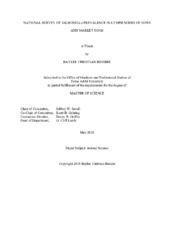| dc.description.abstract | Livestock are known to harbor Salmonella in their gastrointestinal (GI) tract and lymphatic tissues. Pathogens on carcass surfaces can be mitigated by antimicrobial interventions applied to the surface. Lymph nodes (LNs) are typically below the surface and encased in fat protecting them from typical antimicrobial treatments, thus serving as a possible root-cause of foodborne illnesses attributed to Salmonella in meat products. To establish a baseline of Salmonella prevalence in porcine LNs across the U.S., twenty-one commercial pork harvest and processing facilities, representing northern (n = 12) or southern (n = 9) geographical regions, participated in this study. As processing volumes allowed, twenty-five carcasses were selected from each establishment, and left and right superficial inguinal LNs (n =1,014 LNs) were removed. For each carcass, left and right LNs were pooled, yielding one sample per animal or n = 507 total LN samples. Salmonella prevalence was determined for all samples. Salmonella prevalence rates differed (P < 0.05) between hog types in both regions. Specifically, 6.4% of market hog and 37.0% of sow LN samples were found to be Salmonella positive in the northern region. This relationship was reversed in the southern region as 13.0% of market hog and 4.8% of sow LN samples returned Salmonella-positive results. Furthermore, there was a difference (P < 0.05) in prevalence rates between northern and southern regions for sows, but not market hogs (P > 0.05). Type of chilling method (conventional, blast, or other) used at each market hog facility (n = 12) was documented. In the northern region, prevalence rates of Salmonella across chilling types were distributed as follows: 20.0, 2.7, and 1.3% positive samples for conventional, combined, and blast chill methods, respectively. Additionally, in the southern region, 20.0% of samples were positive for conventional, 0.0% for blast, and 12.0% for other. In both regions, samples from conventionally chilled carcasses returned more (P < 0.05) positive results than any other chill method. Results of this study provide a much-needed baseline for Salmonella prevalence rates in LNs of sows and market hogs in the U.S. | en |


